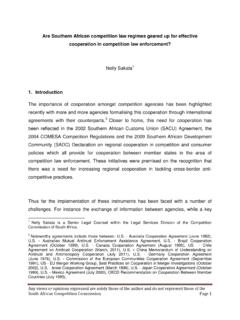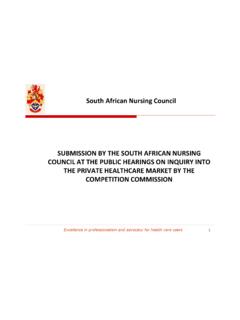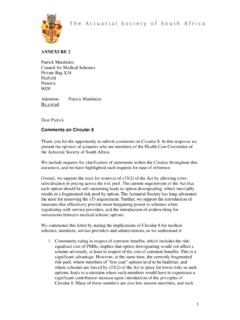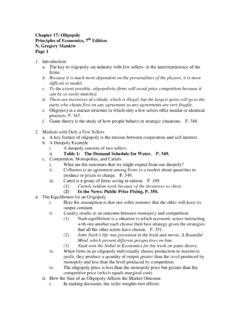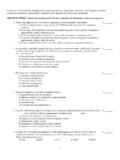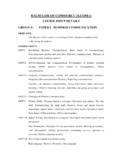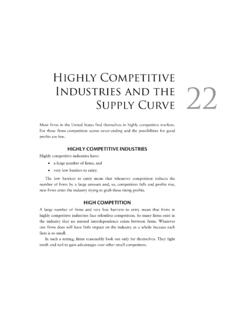Transcription of Market access and oligopoly: Food and Agro …
1 Market access and oligopoly : food and agro - processing Liberty Mncube, Chief Economist Competition Commission 12 March 2015 Some highlights of the Commission s record oMergers oCartels oAbuse of dominance Case studies oTimelines in terms of cartel in the grain industry oBread cartel oFlour cartel oMaize meal cartel oStrategic barriers created by the cartel oPioneer Foods settlement oWal-Mart/Massmart Merger Plan food and agro - processing sector was prioritised by the Commission in 2008 oSignificant value-add opportunities ohigh labour absorption potential food products produced in the sector are essential products bought by all consumers and make up a high proportion of household expenditure especially the poor households. oBasic food products affecting the poor (uncovering cartels in bread, maize meal, baking flour, milk, eggs)
2 OPreventing abuse of dominance oInnovative remedies such as the Wal-mart/Massmart merger oBlocking anticompetitive mergers such as Pick n Pay/Fruit & Veg merger Anti-competitive conduct in the sector has a grievous ramifications oSpread of ownership of the economy, particularly the poor oConsumer welfare and the poor oEmployment Some highlights Commission s extensive investigations into this sector have seen administrative penalties to the value of about R986 million being paid by firms for anti-competitive conduct in the period from 2004 to 2013 oAbout paid between 2004 and 2008 oAbout paid between 2009 and 2013 Some highlights Industry Fines in each period 2004 - 2008 2009 - 2013 Poultry R16 732 Wheat, White Maize Milling and Bread R294 503 R634 284 Fisheries R36 871 Rainbow Farms R1 000 Total for the sector R294 503 R691 509 The main objection to collusion is that it leads to a transfer of wealth and to inefficiencies.
3 OPrices under the cartel are higher and firms are able to appropriate some of the consumer surplus that would go to consumers in competitive markets. oThere is a decrease in the aggregate quantity produced which causes total welfare to decrease. Harm caused by cartels Cartels in the grain industry Industry background oUnder the apartheid regime, markets for most agricultural products were regulated oWhile liberalisation removed direct controls, the subsequent uncovering of cartels suggests that extensive anti-competitive arrangements replaced direct regulated control Flour Market oHighly concentrated 4 major firms in the milling industry namely Pioneer Foods, Tiger Brands, Premier Foods and Foodcorp All involved through their various divisions, in the wheat milling and baking industries. These four firms account for more than 90 % of all milled wheat sales.
4 OHomogenous product oMulti- Market contact oHistory of collusion oMarket transparency oGreater similarity on any dimension oHigh barriers to entry Structural factors of a Market can be conducive to successful collusion and can sharpen the accuracy of inferences on the ultimate question of whether firms are engaging in collusive conduct Bread Market oHomogenous product oMulti- Market contact oHistory of collusion oMarket transparency oGreater similarity on any dimension Market structure in the wheat to f lour value chain Bread cartel Cartel members included Premier Foods, Tiger Brands, Pioneer food and Foodcorp) oPremier Foods granted leniency for disclosing its role in the bread cartel, flour cartel and maize meal cartel. oTiger Brands granted leniency for proving further evidence on the flour cartel and maize meal cartel. oFor the bread cartel: o2007 Premier Foods (R0 million) received immunity.
5 O2007 Tiger Brands (R98 million). o2009 Foodcorp (R45 million). o2010 Pioneer Foods (R196 million) after a contested hearing. Bread and Flour Cartels Flour cartel Cartel members included Premier Foods, Tiger Brands, Pioneer food and Foodcorp) ofixing price and Market division through customer allocation. oThe matter was referred to the Tribunal in March 2010 oTiger Brands and Premier Foods granted immunity. In December 2007, the Commission received a complaint from Mossel Bay Bakery. oMossel Bay Bakery alleged that Sasko owned by Pioneer Foods (Pty) Ltd engaged in predatory pricing. oMossel Bay Bakery alleged further that, Sasko threatened it with price wars if it did not increase its price of bread. oIn February 2010, after contested proceedings, the Tribunal found that Pioneer Foods had been involved in a conspiracy to fix the prices of bread as well as Market allocation in the Western Cape province and nationally.
6 Strategies to drive out entry by the cartel Pioneer Foods undertook in terms of the proposed settlement agreement to: oPay a fine of R500 million to the National Revenue Fund. oFurther, an agro - processing Competitiveness Fund of R250 million drawn from the penalty was conceptualized. Direct Investment Business Support Research Grant Fund size 225 000 000 12 500 000 12 500 000 Committed 212 421 470 2 867 120 10 276 629 Funds available 12 578 532 9 632 880 2 223 371 Interest is at 0%, total ref lows of million achieved. All ref lows will be invested in new clients. Pioneer Foods Settlement A summary of agro - processing competitiveness fund STATUS No. OF CLEINTS AMOUNT On-track 23 146 647 720 Under supervision 7 61 373 750 Legal action 1 4 400 000 Ceased operations 0 0 Total 31 212 421 470 PROVINCE VALUE (Rand) NO. OF DEALS JOBS Mpumalanga - - - Western Cape 39 125 000 10 120 Gauteng 68 305 042 9 283 Eastern Cape 13 885 000 4 746 Limpopo 35 716 428 4 224 Kwa-Zulu Natal 16 900 000 5 69 Northern Cape - - - North West 5 500 000 1 19 Free State 35 857 120 5 873 Total 215 288 590 38 2 334 Geographical spread of APCF Pioneer Foods undertook in terms of the proposed settlement agreement to: oReduce the prices of certain of its products for an agreed period of time up to the total value of R160 million.
7 O Increase its capital expenditure budget by R150 million. Pioneer Foods Average wholesale and retail prices for Pioneer Foods standard white bread, 06/2010 -06/2011 Some background oWorlds largest corporation, revenue larger than SA GDP oAbout three times bigger that the closet retail rival oHistory of a bad relationship with trade unions oControversy over its effect on local communities oEntry preceded by retrenchments at the target firm oPoor Engagement with stakeholders upon entry oAND oGovernment growth path sets employment targets Responses oGovernment concerned that Wal-Mart will use its global reach to source products globally, displacing local manufacturers and jobs oTried to negotiate a Social Accord with Wal-Mart covering local procurement and labour issues oWal-Mart objected to being subjected to local procurement requirements on discriminatory basis oWal-Mart argued that its entry will bring prices down oDenied that it had a global sourcing strategy argued that its strength lied in leveraging on its logistics efficiencies oOffered to create a local supplier development fund of about $ 10 million oWhen negotiations failed, government belatedly intervened in the proceedings before the Competition Tribunal, joining trade unions Entry of Wal-Mart into SA In May 2011, the merger was approved with conditions: oNo retrenchments from the merged entity s operations in South Africa for a period of two years.
8 OThe parties must reinstate the 503 employees that were retrenched during 2009 and June 2010 (no time period specified for this condition). oThe merged entity must honour the existing labour agreements with SACCAWU for at least 3 years. oMassmart must establish a Supplier Development Fund (SDF) by February 2013. oR242 million was set aside as SDF which was envisaged to operate for 5 years. oThe purpose of the fund is to assist eligible South African Small and Medium Enterprises, particularly black-owned, black-empowered or local manufacturers. oEnabling Massmart to increase and diversify its local procurement capacity. The Wal-Mart/Massmart Merger Fund investment spend forecast (over 5 year duration) Value available to commit per investment area as at September 2013 Value of disbursements per investment area as at September 2013 Ezemvelo Direct Farm Programme R67 760 000 R18 332 440 R16 859 827 Manufacturing SMEs R96 800 000 R92 876 311 R773 689 Service projects R9 680 000 R8 236 524 R721 738 Service to suppliers R19 360 000 R0 R775 630 TOTAL R193 600 000 R119 445 275 R19 130 884 Wal-Mart/Massmart Merger Source: Massmart Supplier Development Fund Annual Report 2013, page 10.
9 A summary of the investment forecast of resources to beneficiaries over the funds 5 year duration THANK YOU
